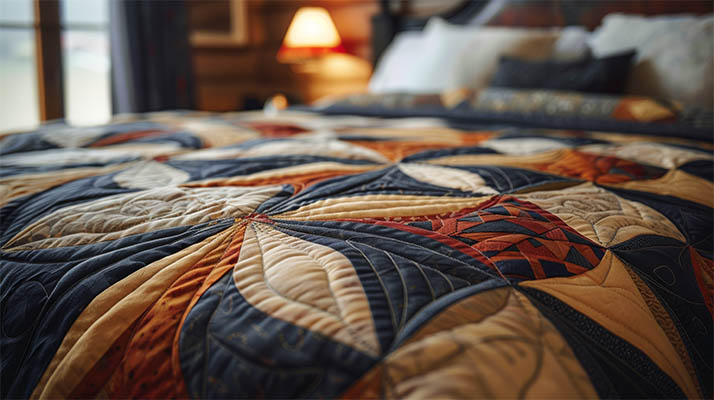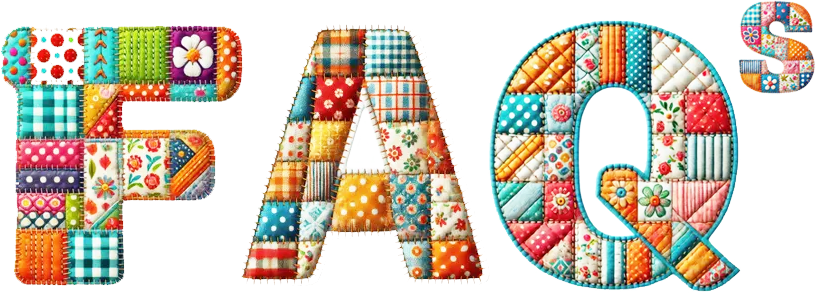Hello, How can we help you?
Below you’ll find answers to the most common questions you may have on the products we sell on our website. If you still can’t find the answer you’re looking for, just Contact us!
Quilting Sewlutions FAQ's
My name is Janette Hopkins. I have been Patchwork and Quilting for over 25 years and teaching Patchwork and Quilting for the last 7 years.
I have a level 3 City & Guilds in Art, Design, Patchwork and Quilting , also a City & Guilds Diploma in Design, Craft, Patchwork and Quilting. More importantly, I am passionate about my Art – and all things quilted !
-
Wash your quilt no more than twice a year, to prevent the fabrics fading.
-
Hand washing is the most gentle way of washing your quilt. You should use a mild detergent, suitable for delicate fabrics.
-
Machine wash on a delicate cycle at 30 degrees maximum temperature. You could put a colour catcher sheet in with the wash ( you can buy them from your supermar-ket ). Hot water will shrink the fabric and may cause colour to run.
-
Avoid bleach & harsh chemicals – they can damage your quilt.
-
Spot clean stains as soon as you can after they occur. Use mild detergent and a soft clean cloth to dab the stain gently ( so the colours don’t bleed ).
-
DO NOT dry clean – this can cause the dyes to run, or fade.
-
Avoid your quilt being in direct sunlight for long periods of time as it will rot the cotton.
- Store in a cool dark place.
- NEVER store in an airtight container or bag. Cutting off air accelerates the decomposition of the cotton.
- The best way to store a quilt is to put it on a bed with a sheet on it, or alternatively roll them.
-
Folding should be avoided long term as this can lead to tears and holes. If you do need to fold it, fold into threewidth ways then in half length ways.
Some people like quilts to just sit on top of the bed, some like the quilt to drape over the side of the bed, some over the sides and the end ! So it is difficult to actually say what size you need.
Hopefully, the following will help you make decisions…..
A single bed mattress measures 36” x 75” ( 90 x 190 cm )
A double bed mattress measures 54” x 75” ( 135 x 190 cm )
A kingsize bed mattress measures 60” x 78” ( 150 x 200 cm )
A superking bed mattress measures (72” x 200 cm)
If you want a “topper”, just get a quilt that roughly measures the same as the bed measure-ments.
If you want the quilt to go over the sides of the bed by 6”, then get a quilt 12” larger ( 6” each side )
A rough guide for a quilt that drapes over the sides of a bed is as follows :
Baby Quilt…30” x 40” ( 76 x 102cms ) – ideal for wrapping babies in, as a playmat to lay a baby on, on the floor, or for décor, draped in a nursery !
Nursery Quilt…36” x 48” ( 91 x 122 cm ) – slightly bigger than a crib quilt, for use in a cot or as a playmat for toddlers.
Single Bed Quilt…55” x 79” ( 140 x 201 cm ) For a child’s bed or guest room
Double Bed Quilt…78” x 79” ( 201 x 201 cm ) For a full size bed & provides more coverage
Kingsize Bed Quilt…84” x 92” (231 x 221 cm ) Provide ample coverage for a comfortable sleep
Superking Bed Quilt…102” x 87” ( 259 x 221 cm ) Extra coverage for a comfy night’s sleep
Still confused ? Give me a ring and I can guide you.
A Raggy Quilt is a baby / nursery quilt made of just two layers ( no wadding ) made of cotton flannel and the design gives fluffy raised soft areas. These are very comfy, ideal for a baby / toddlers.
A lap quilt is generally smaller than a bed quilt. It’s usually used when you are sitting on a chair or sofa, relaxing. They are perfect to snuggle under on a cold winter’s evening. When not in use they can be used as a decorative throw.
They can vary in size, and are usually between 36” x 48” (90 x 120 cm ) and 50” x 60” (125 x 150 cm ). There are really no absolute sizes – just what you find most comfortable with.




